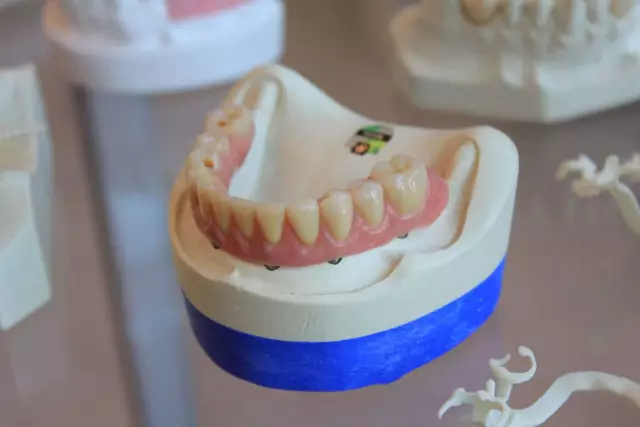- Author Curtis Blomfield [email protected].
- Public 2023-12-16 20:44.
- Last modified 2025-01-23 17:01.
Symptoms of periodontitis, inflammation of one of the root membranes of the tooth, can occur in the acute and chronic forms of this disease with almost the same intensity. It usually develops as a consequence of neglected caries and its unprofessional treatment, as well as due to an inflamed nerve.

Symptoms of periodontitis and its diagnosis
The mechanism of infection penetration into the root canal and its surrounding tissues may be different. But the symptoms of periodontitis are similar in all cases: a sharp pain (localized near a certain tooth), which becomes unbearable from touch and from hot drinks, an enlarged tooth syndrome (the patient feels that he seems to protrude from the gums and becomes mobile), swelling and swelling of the soft tissues. This ailment can also provoke a deterioration in the general condition of the patient - the temperature rises, the head may hurt, the content of leukocytes in the blood increases.
Diagnosis of periodontitis is complicated by the fact that the appearance of the periodontal gap practically does not change andan x-ray may not show any signs of illness.

In order to assess the condition of the tooth, you need to consult an experienced dentist. Symptoms of periodontitis can be a reaction to medications, past systemic diseases (diabetes and some others), lack of vitamins in food. Also, the cause may be untimely removal of tartar, poor oral care. Acute periodontitis is accompanied by an abundant development of pathogenic flora on the surface of the gums (staphylococci can coexist with pneumococci and streptococci). If it is not treated in a timely manner, it threatens to destroy the ligament of the tooth and the surrounding bone tissue.
One of the subspecies of the disease is fibrous periodontitis - the degeneration of periodontium into fibrous tissue. In this case, pathogenic processes proceed slowly, they are difficult to diagnose. Also, for a complete picture, it is necessary to name granulomatous and granulating periodontitis. The first is characterized by the formation of a connective tissue sac at the top of one of the roots of the tooth.

But the appearance of fast-growing granulation tissues that destroy the alveolar plate is characteristic of such a disease as granulating periodontitis. The medical history in this case often contains information about fistulas that open on the chin or near the jaw. Moreover, the closure of the fistula is usually accompanied by an increase in pathology.
Treatment of periodontitis
First, it is necessary to eliminate the focus of acute inflammation and createconditions for the regeneration of a diseased tooth and the restoration of its functions. The dentist will clean the canals by removing the remnants of the affected tissue and fillings from their lumen, if they were placed. This process takes place in stages with the help of special tools and antiseptic preparations. After cleaning, an antibacterial agent is introduced into the canal, which is left for a day and replaced as necessary with a new portion. After the inflammation is eliminated, it is necessary to stimulate the regeneration of the periodontium and only then make a temporary or permanent filling.






